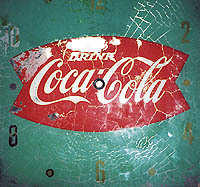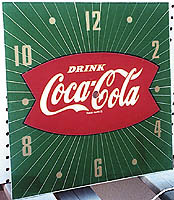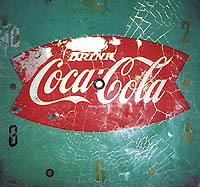Nostalgia is a tonic for modern society. The pace of life is made easier by memories of the way things were, when time seemed slower. Reminiscing is more than a history lesson — it’s appreciating life. A new season, a new year and even a new millennium can bring on these sorts of memories.
Restoring old memorabilia inspires history buffs, collectors and anyone with a fondness for links to the past. However, time can deteriorate vintage antiques and collectibles, and methods and materials used in their creation often become obsolete. Economical substitutes — like vinyl graphics — for original materials are often required to restore an object.
My project involved restoring a 15-in. square backlit glass panel clock to its original condition. To create a new face for a Coca-Cola™ clock, circa the ’50s or early ’60s, I used green, gold, tomato-red and white vinyl and paint. Because the original was screenprinted, using translucent inks, it was a challenge to match, especially within the established $80 budget.
For the project, I also used the following tools and materials: Sign Art Gold clipart; Gerber Scientific Products’ GRAPHIX ADVANTAGE® software; a Gerber HS 15 plotter; application masking; Sharpie markers; an HP Scanjet 3C scanner; Avery Graphics’ translucent red and green vinyl; 3M’s ScotchCal™ opaque gold metallic vinyl; Vinyl Tech® white aerosol paint; GROG™ paint, vinyl, and adhesive lifter; ActionTac™ application fluid; a 4-in. razor paint scraper; and brushes, scuffs and scrunge pads. $image1
Designing the artwork
To design the artwork, use pre-made clipart, hand-traced forms and computer-generated detailing. The Coca-Cola image was taken from the Sign Art Gold collection, matching the word "DRINK" with a font from Graphix Advantage. With a Sharpie marker, trace the double fishmouth design and numerals on the clock onto an application mask, then scan them into Composer software, editing for style and size.
Advertisement
To recreate the measured lines projecting from the Coca-Cola logo in the original, draw in Composer a .02-in.-wide vertical line through a 15-in. square panel, then copy and paste it back, rotating each line six degrees until all lines are in place. Then, merge the lines into one shape.
Having an accurate registration plotter is very helpful. All the components are ready for the next step — cutting the appropriate color of vinyl. Due to the width limitation of the plotter, the green parts should be cut and assembled as two pieces along the horizontal line.
Out with the old, in with the new
To prepare the panel, remove the deteriorated inks from the glass. Be sure to mark the numbers’ positions to correctly place them. Apply GROG paint, vinyl and adhesive lifter, which sets for 5-10 minutes. Scraping and wiping with a scrunge pad removes the old graphics. Next, rinse the piece with water to deactivate the GROG, then prep with denatured alcohol.
At this point, reverse-cut all the pieces for the second surface application and then dry-install the opaque numbers and dots. Using the traced marks on the face of the glass, wet-install with ActionTac™ the green translucent panels, followed by the red panel. Translucent vinyl installs better wet than dry due to fogging problems. $image2
Applying the paint
Advertisement
After installation, the next step is to backcoat the piece. Spray Vinyl Tech aerosol paint in three light coats to provide the white portion of the design and create a diffusing layer. This could have been done with diffuser film, but color cutouts would create excessive air pockets, even if applied wet. Vinyl Tech works well with vinyl, and its pigments apply better, diffusing rather than blocking backlighting.
The client for this project is an avid collector of antiques and memorabilia. Like me, he has been very satisfied with the results of vinyl usage.


 Tip Sheet3 days ago
Tip Sheet3 days ago
 Business Management2 weeks ago
Business Management2 weeks ago
 Women in Signs2 weeks ago
Women in Signs2 weeks ago
 Real Deal4 days ago
Real Deal4 days ago
 Editor's Note1 week ago
Editor's Note1 week ago
 Benchmarks12 hours ago
Benchmarks12 hours ago
 Line Time2 weeks ago
Line Time2 weeks ago
 Product Buying + Technology1 week ago
Product Buying + Technology1 week ago


















